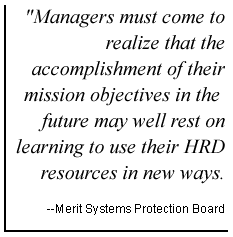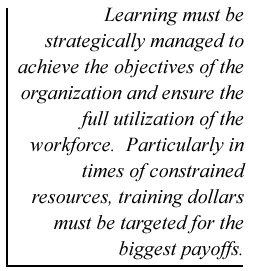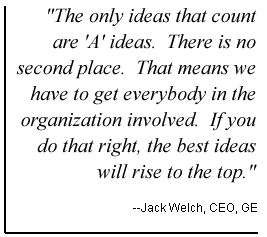If you don't have all the answers, you're not alone. Most government offices are not aware of the best ways to develop their employees and thus protect their major investment and primary asset — human capital.
Often leaders do not know how much or what kind of training is directed toward their organization's real priorities. The 1993 report of the Vice President's National Performance Review found the 1989 Volcker Commission's conclusions in this area still relevant:4
With few exceptions, most federal training is voluntary, individually focused . . . and bears little discernible relation to major agency objectives and missions . . .
Agencies are not sure what they should train for (short term or long term), who should get the lion's share of resources (entry level or senior level), when employees need additional education (once a year or more often) and whether mid-career education is of value . . .
At both the career and presidential level, training is all-too-often ad hoc and self-initiated . . .5
 The Merit Systems Protection Board, in a 1995 study on human
resource development (HRD) in the federal government, found that:
The Merit Systems Protection Board, in a 1995 study on human
resource development (HRD) in the federal government, found that:
- Employees were sent to training for a variety of reasons not always
related to performance needs.
- Many employees reported not receiving the training they needed to
perform their jobs.
- Budget constraints were only part of the problem. More serious
were the findings that training needs assessment procedures were often
inadequate, and training was rarely linked to strategic planning for the
organization.
- Some HRD specialists did not have the skills to support management in meeting organizational needs.
In its recommendations, the Board noted that "many organizations in the Government will have to fundamentally change the way they have looked at training and development . . . Managers must come to realize that the accomplishment of their mission objectives in the future may well rest on learning to use their HRD resources in new ways."6
Clearly, government offices are not going to get results when training
is used as a tactical event, doled out on a first-come-first-served basis,
or treated as a reward or high-cost "perk" for top leaders and
professionals.  Learning must be strategically managed to achieve the objectives
of the organization and ensure the full utilization of the workforce.
Particularly in times of constrained resources, training dollars
must be targeted for the biggest payoffs.
Learning must be strategically managed to achieve the objectives
of the organization and ensure the full utilization of the workforce.
Particularly in times of constrained resources, training dollars
must be targeted for the biggest payoffs.
Most managers are only just realizing that they are the ones who have the business knowledge and the power in and across their own units to introduce new learning processes that will get results. They should be "getting everybody from the top of the human organization to the bottom doing things that make the business successful."7
In the private sector, those corporations that have made a significant commitment to workforce learning are realizing equally significant benefits.
- Major corporations such as Motorola, Ford Motor, 3M, Federal
Express, and Shell Oil have succeeded by continuously learning, by
constant questioning and reflection and redefinition. Shell Oil
managed the 1986 oil crisis far better than other oil companies because
of its learning practices in building scenarios and strategic
planning.8
- Motorola calculates that every $1 spent on training delivers $30 in
productivity gains within three years.9
- Corning reports that its upfront investment in training has "a
payback that is quite impressive." Productivity is up, profits are
up, defects and waste are down.10
- Skandia, Dow Chemical, and Hughes Aircraft deliberately measure and
manage the knowledge assets of their companies and have shown that
enhancing knowledge assets improves financial performance.11
- GE targets its training budget with precision, and invests in
"work-outs," corporate town meetings to solve organizational problems.
"When an industry is in turmoil, productivity and people become
the name of the game. That's where we get our edge."12

- A recent American Management Association survey of 1,003 large and
mid- sized corporations showed that companies that increased their
training after announcing layoffs were twice as likely to report
improved profits and productivity as the firms that didn't invest in
training. Among those that expanded training, 79 percent boosted
long-term profits and 70 percent raised productivity.13
- A study by the National Center on the Educational Quality of the
Workforce at the University of Pennsylvania found that a dollar invested
by a company in employee education was more than twice as effective in
boosting the firm's productivity as a dollar invested in new
machinery.14
Like their corporate counterparts before them, government leaders now face their own turbulence of reinvention, downsizing, and the heavy loss of knowledge workers through retirement. At the same time, the Government Performance and Results Act makes every agency accountable for strategic planning, measurement, and accomplishment of objectives.
These are all compelling reasons to find new ways to tap human capital to increase performance and productivity. President Clinton and Vice President Gore underscored the importance of unlocking the enormous human potential of the federal workforce in the recent Blair House Papers, their reinvention "marching orders" to the Cabinet.15 Since learning is the essential process in expanding the capabilities of people and organizations, the next chapter outlines some approaches to learning that will give managers results.